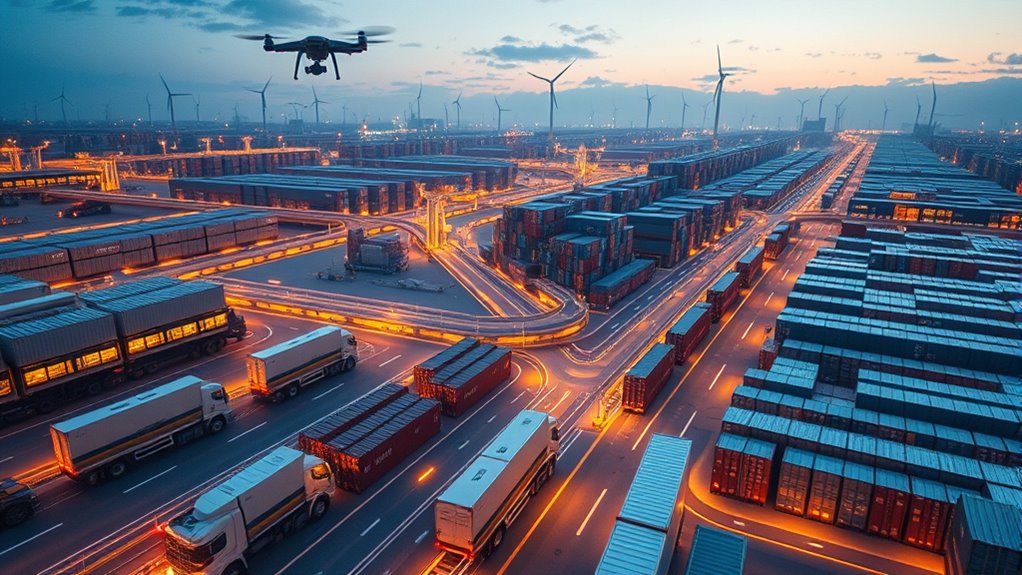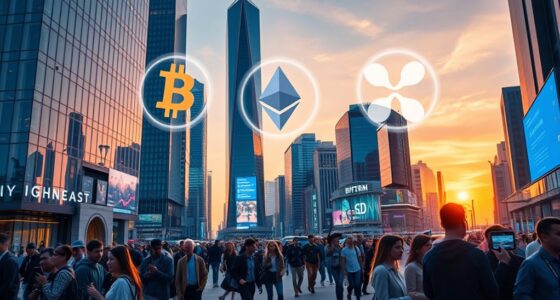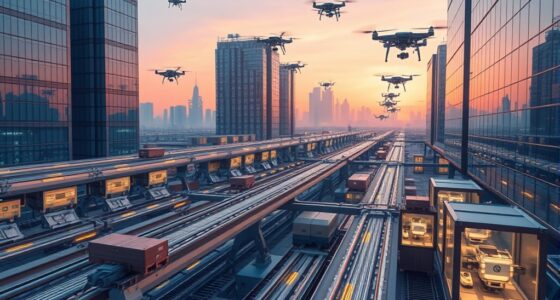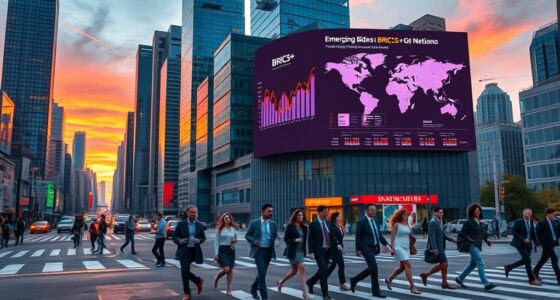By 2025, your supply chains will be faster, greener, and more resilient, driven by digital tech and sustainable practices. Expect real-time data sharing, AI-driven logistics, and eco-friendly transportation to improve efficiency and reduce costs. Companies will work closer together through interconnected platforms, making disruptions easier to manage. If you want to understand the key innovations powering this transformation and how they’ll impact your business, there’s more to explore ahead.
Key Takeaways
- Supply chains will be more resilient, sustainable, and environmentally conscious, driven by digital transformation and consumer demand.
- Advanced technologies like AI, IoT, and automation will enhance visibility, decision-making, and responsiveness across global networks.
- Innovative practices such as route optimization and circular models will reduce emissions, waste, and operational costs.
- Closer collaboration and interconnected platforms will enable proactive risk management and seamless information sharing.
- Overall, supply chains will be faster, greener, and more transparent, aligning with market and environmental sustainability goals.

How will global supply chains look in 2025? You’ll likely see a landscape that’s more resilient, efficient, and environmentally conscious than ever before. The pandemic exposed vulnerabilities in traditional supply chain models, prompting a shift toward sustainable logistics and a robust digital transformation. You will notice that companies are increasingly prioritizing eco-friendly practices, integrating sustainable logistics into their core strategies to reduce carbon footprints and waste. This shift isn’t just about corporate responsibility; it’s driven by consumer demand, regulatory pressures, and the long-term cost savings that come with greener operations. As a result, supply chains will be optimized to minimize environmental impact while maintaining agility and responsiveness.
Digital transformation will be at the heart of this evolution. You’ll see companies leveraging advanced technologies like artificial intelligence, machine learning, and the Internet of Things to enhance visibility and decision-making across the entire supply chain. Real-time data sharing becomes commonplace, allowing you to track shipments, inventory, and production schedules with unprecedented accuracy. This transparency helps identify bottlenecks before they escalate, reducing delays and costs. Automation will play a significant role, streamlining warehouse operations and transportation management, enabling faster, more flexible responses to market demands. In essence, digital tools will empower you to manage complex supply networks with greater precision and confidence.
Sustainable logistics and digital transformation will work hand in hand. For example, innovative route planning algorithms will optimize delivery routes to cut emissions and fuel consumption while ensuring prompt deliveries. Electric and alternative fuel vehicles will become standard in many fleets, supported by smart infrastructure that charges and maintains them efficiently. You might also notice that more companies are adopting circular supply chain models, emphasizing reuse, recycling, and refurbishment to reduce waste and resource consumption. These practices not only support environmental goals but also create more resilient supply chains that can adapt to disruptions. Incorporating advanced technology such as AI-driven analytics and IoT sensors will further enhance the ability to predict and respond to supply chain disruptions proactively.
Furthermore, the integration of digital platforms will facilitate closer collaboration among suppliers, manufacturers, and retailers. You’ll be part of a network where information flows seamlessly, enabling joint planning and risk mitigation. This interconnectedness helps you anticipate disruptions, adjust inventories proactively, and respond swiftly to global changes. Overall, by 2025, global supply chains will be more sustainable and digitally driven, transforming the way you think about logistics. You’ll experience faster, greener, and more transparent operations that better serve your needs and those of the planet. This reinvention isn’t just a trend—it’s a necessary evolution to thrive in the complex, interconnected world of tomorrow.
Frequently Asked Questions
How Will Geopolitical Tensions Impact Supply Chain Resilience by 2025?
You’ll find that geopolitical tensions will challenge your supply chain resilience by increasing trade barriers and disrupting established routes. As nations adopt tougher diplomatic strategies, expect delays and higher costs. To stay resilient, you’ll need to diversify suppliers, strengthen regional partnerships, and stay adaptable. Proactively managing these risks allows you to navigate uncertainties more effectively and maintain supply chain stability despite escalating geopolitical tensions.
What Role Will Artificial Intelligence Play in Supply Chain Management?
Like Icarus soaring higher, AI will elevate your supply chain management through AI optimization and predictive analytics. You’ll gain real-time insights, automate complex processes, and anticipate disruptions before they happen. This proactive approach enhances resilience, reduces costs, and improves efficiency. As your trusted navigator, AI empowers you to make smarter decisions, keeping your operations agile and competitive in a rapidly changing global landscape.
How Will Climate Change Influence Future Supply Chain Strategies?
Climate change will push you to prioritize renewable sourcing and climate adaptation in your supply chain strategies. As weather patterns become more unpredictable, you’ll need to diversify suppliers and invest in sustainable materials to reduce risks. Embracing renewable sources and flexible logistics allows you to stay resilient, minimize disruptions, and meet evolving regulations, ensuring your supply chain remains efficient and environmentally responsible amidst a changing climate.
What Are the Projected Costs of Supply Chain Disruptions in 2025?
You can expect supply chain disruptions to cost businesses billions in 2025, with estimates varying based on risk evaluation and industry. Conducting thorough cost estimation helps you prepare for potential losses from delays, shortages, or damage. By proactively analyzing risks, you’ll better understand vulnerabilities and allocate resources effectively, minimizing financial impacts. Staying vigilant and adaptable ensures your supply chain remains resilient, even amid increasing global uncertainties.
How Will Consumer Behavior Shifts Alter Supply Chain Priorities?
Think of your supply chain like a river constantly changing course. As your digital consumption grows, you’ll need to prioritize agile, personalized logistics to meet evolving demands. Consumer shifts mean faster delivery expectations and a desire for tailored experiences, prompting supply chains to adapt by embracing technology and data-driven solutions. This guarantees you stay responsive, competitive, and aligned with customer preferences in a landscape where flexibility becomes your strongest asset.
Conclusion
By 2025, you’ll see global supply chains rebounding and transforming into more resilient, flexible systems. Some might worry that change is slow or risky, but embracing innovation now means fewer disruptions later. You can stay ahead by adopting new technologies and diversifying your suppliers. Remember, those who adapt early will not only survive but thrive in the evolving landscape. So, don’t wait—reinvent your approach today for a stronger, more reliable supply chain tomorrow.









